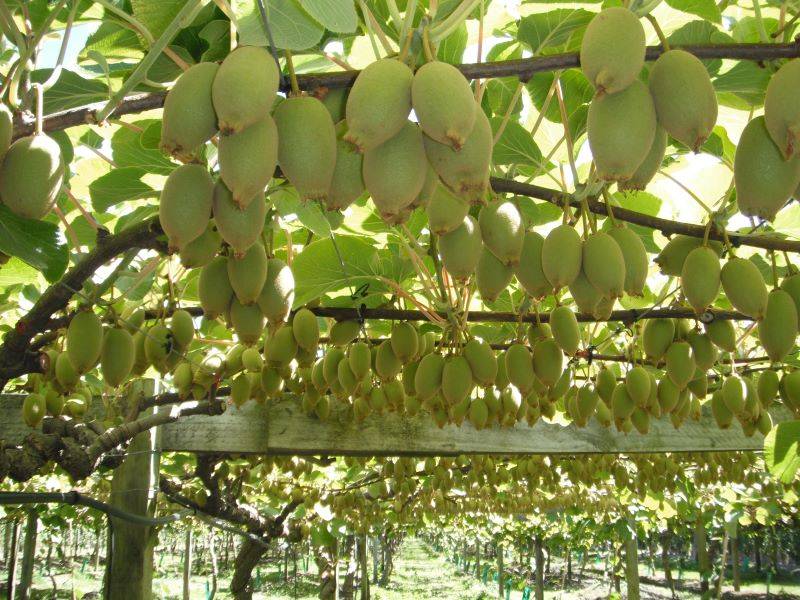
Commercial kiwi farming is a relatively new growing business in several areas. As a result, you can profit from this opportunity. The Kiwi fruit is native to China, also known as Chinese gooseberry. This small sweet and tangy fruit is filled with so many nutrients and thus offers numerous health benefits. In India, Kiwi is mostly grown in Jammu Kashmir, Himachal Pradesh, Sikkim, Meghalaya, Arunachal Pradesh, Uttar Pradesh, and Kerala.
Soil requirements and Climate
Kiwi fruit may be grown in warm and humid environments. A deep yellow-brown loamy soil that is well-drained and fertile is ideal for kiwi farming. Nitrogen (200kg/ha), potassium (150kg/ha), and phosphorus (55 kg/ha) levels must be monitored on a regular basis once cropping begins. However, providing shelter from the wind is critical since wind can harm the kiwi plant, its little blossoms, and immature fruits.
Land Preparation
Steep land can be contoured into terraces for kiwi plantations. Plants should receive as much sunlight as possible, therefore rows should be aligned north-south. Because January is the best month for kiwi plantation, pitting and manuring should be completed by December.
Plantation
Kiwi plants can be propagated by seed/seedling/grafting. And plantation is usually done in the month of January. For the plantation, arbor or pergola system framework is used with 6m distance in rows. And for the pollination in plants, the male to female plants ratio is maintained at 1:5.
Cold Protection
During Spring and Autumn, protection from cold is necessary, otherwise, it will damage kiwi vines. Wind machines and water sprinklers can be used to protect kiwi vines.
Fertilizer Requirements
Every year, 20kg farmyard manure and 0.5 kg NPK mixture containing 15% Nitrogen are necessary for good kiwi growth. After 5 years, apply the same amount of farmyard manure and NPK as described, 850-900 g of nitrogen, 500-600 g of phosphorus, and 800-900 g of potassium each year.
Kiwi Pruning and Training
Pruning is required as kiwi vines grow in large quantities and become overloaded. Pruning should begin as soon as the vine is planted. Instead of focusing on how to chop a kiwi in the first year, the main focus should be on straight growth and a robust framework. Tie the vine loosely to the pole and keep it growing straight up. The vines should not be wrapped around the pole. All side branches should be clipped until the vine reaches the pole's top.
Remove the top half of the vine and encourage side shoots to grow laterally along the wires of the framework. Winter is the best season for pruning. If the vine does not create healthy side branches at the top, trim the main branch by approximately 2 feet and attempt growing it and forming proper side branches at the top again the following year.
Irrigation
Irrigation should be provided in September-October month when the fruit is in the initial stage of growth. Irrigation in 10-15 days of intervals is beneficial for the healthy growth of plants and fruits.
(You must be interested to know Most Innovative Irrigation System)
Intercropping of legumes and vegetables can be done with the kiwi plants. And one thing that can be noted is that no serious pests or diseases are observed in the cultivation of Kiwi, just proper and regular care is sufficient.
Harvesting
Kiwi plants begin bearing fruits after 4-5 years, but commercial production begins after 6-7 years. Because of the temperature difference, fruits mature faster at low altitudes than at high elevations. Larger fruits are harvested first, and smaller fruits are allowed to grow for a longer period of time. Hard fruits are wrapped in a coarse cloth and taken to the market, where they soften and become edible after a few days, i.e., 1-2 weeks.
Yield rate of 50-100 kg per vine is observed in Kiwi plants.
(you can also go through Cultivation of Star Fruits)
Marketing of Kiwi
Growers can sell their Kiwi through agents in the market or for online selling, you can refer to the following links.
https://www.exportgenius.in/india-importers-of-kiwi
https://www.infodriveindia.com/indian-importers/fresh-kiwi-importers.aspx
For more information like this, Stay Connected…!!











